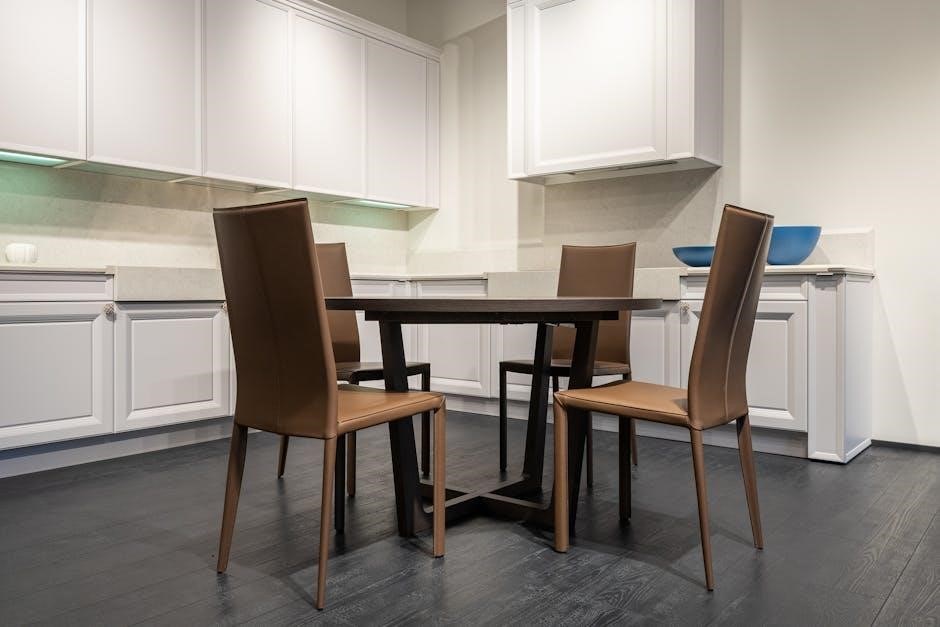Earn the Cadette New Cuisines Badge by exploring global and historical dishes. This 8-page guide provides steps to create amazing meals from around the world and through time, perfect for culinary adventurers. Discover new flavors and cooking techniques while learning about diverse cuisines and their cultural significance. This badge is designed to inspire creativity and confidence in the kitchen, helping you become a skilled chef and storyteller through food.
Overview of the Cadette New Cuisines Badge
The Cadette New Cuisines Badge is an exciting opportunity for Girl Scouts to explore the world of food and cooking. This badge is designed for Cadettes (grades 6-8) and focuses on discovering global and historical cuisines, as well as regional U.S. dishes. The 8-page pamphlet provides a comprehensive guide, outlining the steps needed to earn the badge. Girls will learn to prepare and share dishes from different cultures and time periods, developing essential cooking skills and cultural understanding. The badge encourages creativity, experimentation, and confidence in the kitchen. By completing the requirements, girls will gain a deeper appreciation for the diversity of global cuisines and the stories behind them. This badge is perfect for those who enjoy cooking, trying new foods, and exploring the rich history of culinary traditions. It’s a delicious journey that combines learning, creativity, and fun!
Steps to Earn the Badge

Earning the Cadette New Cuisines Badge involves five key steps: exploring global cuisines, preparing historical dishes, cooking a dish from another country, making a regional U.S. dish, and sharing your creations. Each step builds culinary skills and cultural awareness.
- Explore global cuisines and their cultural significance.
- Prepare and share historical dishes.
- Cook a dish from another country.
- Make a regional U.S. dish.
- Share your culinary creations with others.
Begin your culinary journey by exploring global cuisines and their cultural significance. Research a country’s cuisine, noting its history, key ingredients, and popular dishes. For example, Italian cuisine emphasizes fresh vegetables, herbs, and cheeses, while Chinese cuisine highlights balance and variety. Document interesting facts about the cuisine, such as how geography or traditions influence food preparation. This step encourages curiosity and appreciation for diverse flavors. Share your findings with your troop, discussing what makes each cuisine unique. Consider preparing a simple dish together to taste the flavors firsthand. This introduction sets the foundation for your culinary adventures, helping you understand the richness of global food traditions. By completing this step, you’ll gain a broader perspective on the world’s cuisines and their cultural importance.

Step 2: Exploring Historical Dishes
Dive into the past by exploring historical dishes that have shaped cuisines over centuries. Start by researching a dish with a rich history, such as Cheese Fondue, which originated as a practical meal during winter months in Switzerland. Learn about its evolution and cultural significance. Next, choose a historical recipe to prepare, ensuring it reflects the era and region you’re studying. For example, you might make a medieval stew or a traditional dish from the American colonial period. Document the ingredients, cooking methods, and tools used historically, comparing them to modern techniques. Share your findings with your troop, discussing how historical events, like trade routes or migrations, influenced the dish. This step helps you appreciate how food traditions have been preserved and adapted over time. By cooking a historical dish, you’ll gain a deeper understanding of its cultural and culinary importance. This hands-on experience will make history come alive through flavor and storytelling.
Step 3: Cooking a Dish from Another Country
Expand your culinary horizons by cooking a dish from a country you’ve never explored before. Start by selecting a nation whose cuisine intrigues you, such as Japan, Italy, or Mexico. Research its culinary traditions, key ingredients, and popular dishes. Choose a recipe that challenges you, like sushi, pasta, or tacos, and gather the necessary ingredients. Follow the recipe step-by-step, paying attention to cooking techniques unique to that culture, such as stir-frying or simmering. As you cook, reflect on how the dish reflects the country’s history, geography, and values. Once prepared, present your dish to your troop or family, sharing fun facts about its origins and cultural significance. This step encourages you to step out of your comfort zone and embrace global flavors, fostering appreciation for diversity and broadening your culinary skills. By cooking an international dish, you’ll connect with cultures worldwide through the universal language of food.
Step 4: Preparing a Regional U.S. Dish
Explore the rich culinary diversity of the United States by preparing a dish from a different region. Choose an area like New England, the South, or the Southwest, each known for its unique flavors and traditions. Research popular dishes from your selected region, such as clam chowder, gumbo, or BBQ. Select a recipe that highlights local ingredients and cooking methods, like seafood in New England or spices in Tex-Mex cuisine. Gather the necessary ingredients and follow the recipe to create an authentic regional dish. As you cook, learn about the cultural and historical influences that shaped the dish. Once prepared, present your creation to your troop or family, sharing interesting facts about its origins and significance. This step helps you appreciate the variety of American cuisine and how geography and history have shaped regional flavors. By cooking a dish from a different U.S. region, you’ll gain a deeper understanding of the country’s diverse culinary heritage.
Step 5: Sharing Your Culinary Creations
Once you’ve cooked your dishes, it’s time to share your culinary creations with others! This step is about presenting your dishes and celebrating your hard work. Host a tasting event for your troop, family, or friends, where everyone can enjoy the flavors you’ve discovered. Share stories about the recipes, their origins, and what you learned during the process. Take photos of your dishes and the people enjoying them to capture the moment. You can also create a scrapbook or digital presentation to document your culinary journey, highlighting the dishes you made and the cultural insights you gained. Sharing your creations is a great way to inspire others and showcase your newfound skills. By presenting your dishes, you’ll not only celebrate your achievements but also share the joy of exploring new cuisines with your community. This step is all about connecting with others through food and fostering a sense of pride in your accomplishments.
Culinary Exploration
Embark on a journey to explore global cuisines, historical dishes, and regional U.S. foods. Discover the cultural significance of ingredients and cooking techniques. This step fosters curiosity and appreciation for diverse flavors, making cooking an exciting adventure of discovery and connection.

Exploring Global Cuisines
Exploring global cuisines is a fascinating way to discover the diversity of flavors and traditions from around the world. Start by selecting a country that interests you and research its cuisine. Learn about the ingredients, cooking techniques, and cultural significance of its dishes. For example, you might explore the spices of Indian cuisine, the pasta dishes of Italy, or the sushi art of Japan. Document your findings and note what makes each cuisine unique. When choosing a dish to cook, opt for something you’ve never tried before to broaden your culinary horizons. Consider the availability of ingredients and any dietary restrictions. Once you’ve cooked the dish, share it with others and discuss what you learned about the culture behind it. This step encourages curiosity, creativity, and an appreciation for global traditions. Remember to take photos and notes for your culinary journal!
- Research a country’s cuisine and its cultural significance.
- Choose a dish to cook that reflects the country’s traditions.
- Document your process and share your experience.
This exploration will not only enhance your cooking skills but also deepen your understanding of global cultures.

Discovering Historical Recipes
Discovering historical recipes is a fun and educational way to connect with the past through food. Start by researching dishes from different time periods, such as medieval stews, colonial-era desserts, or ancient Roman meals. Choose a recipe that fascinates you and learn about its origins, ingredients, and cooking methods. For example, cheese fondue, a dish with centuries-old roots, was originally a way to use aged cheeses and bread during harsh winters. Adapt the recipe to modern kitchens while staying true to its historical essence. Cook the dish and share it with others, explaining its historical significance. This step helps you appreciate how food has evolved and reflects the traditions of earlier times. Keep a journal of your findings and the challenges you face in recreating historical dishes. This journey will deepen your understanding of history and cuisine!
- Research a historical dish and its origins.
- Cook the dish using adapted methods.
- Share the dish and its story with others.
This process will connect you to the past while sharpening your culinary skills.
Understanding Regional U.S. Foods
Exploring regional U.S. foods is a delicious way to discover the country’s diverse culinary heritage. Each region boasts unique dishes shaped by its history, culture, and geography. For example, New England is famous for seafood, while the South is known for hearty dishes like fried chicken and grits. The Southwest offers bold flavors with tacos and chili, and Hawaii brings tropical twists with poke and kalua pig. Choose a region that interests you and research its iconic dishes. Try cooking a popular recipe from that area, such as clam chowder from New England or gumbo from the South. Share your creation with family or friends and discuss what makes it representative of its region. This step helps you appreciate how geography and culture influence food traditions. Keep track of the ingredients and cooking techniques used in each dish to better understand regional differences. By exploring these flavors, you’ll gain a deeper connection to America’s rich culinary diversity.
- Research a U.S. region and its signature dishes.
- Cook a traditional recipe from that region.
- Share and discuss the dish’s cultural significance.
This journey will broaden your palate and appreciation for regional U.S. foods.

Planning Your Culinary Tour
Planning your culinary tour is an exciting part of earning the Cadette New Cuisines Badge. Start by researching different cuisines and dishes you want to explore. Decide which countries or regions you’re interested in and create a list of recipes to try. Organize your tour by theme, such as focusing on a specific continent or historical era. Make a timeline to ensure you complete all steps and share your progress with your troop. Involve your group in decision-making to ensure everyone is excited about the dishes you’ll prepare. Budgeting and grocery shopping are also important parts of the planning process. Consider any dietary restrictions and plan accordingly. Finally, schedule a presentation to share your culinary creations with others. This step-by-step approach will help you stay organized and make the most of your culinary journey.
- Research and select dishes from different regions or time periods.
- Create a timeline for completing all badge requirements.
- Involve your troop in planning and decision-making.
- Plan for budgeting, shopping, and dietary needs.
- Schedule a presentation to share your creations.
With careful planning, your culinary tour will be both educational and enjoyable!

Kitchen Safety and Hygiene
Kitchen safety and hygiene are essential skills for any aspiring chef, especially when working toward the Cadette New Cuisines Badge. Always wash your hands before starting to cook and after handling raw ingredients. Ensure all utensils and surfaces are clean to prevent cross-contamination. Use oven mitts when handling hot dishes, and keep long hair tied back to avoid accidents. Teach your troop about proper food storage and the importance of using separate cutting boards for meats, vegetables, and dairy to maintain hygiene. Additionally, be mindful of food allergies and take steps to accommodate them. By following these guidelines, you’ll create a safe and enjoyable cooking environment for everyone involved.
- Wash hands frequently and clean all utensils and surfaces.
- Use oven mitts and protect yourself from hot surfaces.
- Store food properly and prevent cross-contamination.
- Be aware of food allergies and take precautions.
Practicing kitchen safety and hygiene ensures a fun and secure culinary experience while earning your badge.

Resources and Tips
The Cadette New Cuisines Badge requires an 8-page pamphlet with step-by-step instructions. Find easy-to-follow guides, tips, and resources online to help you and your troop succeed. Download the PDF for a comprehensive culinary journey.
Guide for Troop Leaders
As a troop leader, guiding your Cadettes through the New Cuisines Badge journey is an exciting opportunity to foster culinary skills and cultural awareness. The 8-page pamphlet provides a clear roadmap, ensuring girls can explore global and historical dishes while learning essential cooking techniques. Encourage girls to step out of their comfort zones and try new flavors. Provide a safe and supportive environment for experimentation, emphasizing kitchen safety and hygiene. Help them research and select dishes from different countries and U.S. regions, ensuring a diverse culinary experience. Encourage collaboration during meal preparation and presentation. Remind them to document their journey and share their creations with the troop or family. The badge requirements are designed to be flexible, allowing girls to choose dishes that interest them most. With your guidance, they’ll gain confidence in the kitchen and a deeper appreciation for global cuisines. Download the PDF guide for detailed instructions and tips to make the process smooth and enjoyable for everyone.
Tips for Successful Cooking
To successfully earn the Cadette New Cuisines Badge, girls should start by planning their culinary journey. Encourage them to research and choose dishes they’ve never tried before, ensuring a diverse and exciting experience. Organization is key: create a menu or checklist to track progress and stay on schedule. When cooking, emphasize the importance of using fresh, high-quality ingredients and proper kitchen tools. Teach girls to follow recipes carefully but also encourage creativity and experimentation with flavors. Safety in the kitchen is paramount—remind them to practice proper hygiene, handle sharp objects with care, and stay attentive while cooking. For dishes from other countries or historical periods, suggest they research cultural traditions to deepen their understanding. Finally, encourage girls to present their creations proudly, sharing stories about the inspiration behind each dish. These tips will help them build confidence, skills, and a lifelong love for cooking and exploration.
Time Management
Effective time management is crucial for successfully earning the Cadette New Cuisines Badge. Start by creating a detailed schedule that outlines each step of the process, from researching global cuisines to preparing and sharing your dishes. Allocate specific time slots for each activity, ensuring you balance cooking, learning, and sharing. Prioritize tasks based on complexity and time requirements, such as allowing extra time for dishes with multiple ingredients or historical recipes that may require special techniques. Consider breaking larger tasks into smaller, manageable steps, like meal planning, grocery shopping, and cooking, to avoid feeling overwhelmed. Encourage girls to stay organized by keeping track of their progress and deadlines. Remind them to schedule regular check-ins with troop leaders or advisors to review their work and address any challenges. By staying focused and adhering to a well-planned timeline, girls can efficiently complete all badge requirements while enjoying the culinary journey. Proper time management will help them make the most of this exciting experience.

Presentation and Sharing
Share your culinary creations with others by presenting dishes in an engaging way. Document your journey through photos, recipes, and stories. Showcase your dishes at a troop meeting or family gathering, highlighting the cultural and historical significance of each meal. Encourage feedback and celebrate your achievements, inspiring others to explore new cuisines. Proper presentation enhances the experience, so consider garnishes, portioning, and creative displays to make your dishes visually appealing. Sharing your passion for cooking fosters connection and pride in your accomplishments, making the badge-earning process even more rewarding.
Presenting Your Dishes
Presenting your dishes is a fun and creative way to share your culinary journey. Start by showcasing your creations at a troop meeting or family gathering, where you can explain the inspiration behind each recipe. Use garnishes, creative portioning, and attractive displays to make your dishes visually appealing. Consider adding a themed setting, such as using traditional utensils or decorations from the dish’s country of origin, to enhance the presentation. Share stories about the cultural and historical significance of each meal, highlighting what you learned during the process. Encourage others to ask questions and provide feedback, fostering a sense of community and shared learning. For a more personal touch, create a menu or recipe cards to accompany your dishes, detailing ingredients and preparation methods. This step not only celebrates your achievements but also helps others appreciate the effort and thoughtfulness behind your culinary creations. By presenting your dishes with pride, you inspire others to explore new cuisines and embrace the joy of cooking.
Documenting Your Culinary Journey
Documenting your culinary journey is a meaningful way to reflect on your experiences and share them with others. Start by keeping a journal or scrapbook where you record each dish you create, noting the recipe, ingredients, and cooking techniques used. Include photos of your finished dishes, as well as any challenges or successes you encountered during the process. Write about the cultural or historical significance of each meal, and how it broadened your understanding of global cuisines. For a digital approach, create a blog or social media page dedicated to your culinary adventures, where you can post updates and stories. Troop leaders can encourage girls to collaborate on a shared document or presentation to showcase their collective journey. This documentation not only serves as a personal memento but also provides a creative way to share your achievements with family, friends, and the troop. By capturing your experiences, you’ll have a lasting record of your culinary exploration and growth.
Conclusion
Earning the Cadette New Cuisines Badge is a rewarding experience that combines culinary exploration, cultural discovery, and personal growth. Through this journey, you’ll gain confidence in the kitchen, develop an appreciation for global flavors, and create lasting memories. By completing the steps, you’ll not only master new cooking skills but also understand the stories behind the dishes you prepare. This badge encourages creativity, teamwork, and a deeper connection to the diverse world of food. Celebrate your achievements by sharing your culinary creations with others, whether through a presentation, a meal, or a documented journey. The skills and knowledge you gain will stay with you forever, inspiring you to continue exploring the rich and varied world of cuisines. Congratulations on completing the Cadette New Cuisines Badge—you’re now a culinary adventurer ready to take on new challenges and delight others with your cooking!

Appendix
This section provides additional resources and tools to support your journey in earning the Cadette New Cuisines Badge. Below, you’ll find helpful materials to enhance your culinary exploration:
- Glossary of Culinary Terms: A list of key cooking terms and phrases to help you understand recipe instructions and ingredient descriptions.
- Measurement Conversion Chart: A handy guide to convert between U.S. and metric measurements, ensuring accuracy in your recipes.
- Recipe Templates: Printable worksheets to document your culinary creations, including space for ingredients, instructions, and notes.
- Further Reading: A curated list of cookbooks, websites, and resources for exploring global and historical cuisines.
- Troop Leader Guide: Tips and ideas for leading activities, managing time, and fostering teamwork during badge completion.
These resources are designed to make your culinary journey enjoyable and educational. Use them to expand your knowledge, stay organized, and share your experiences with others. Happy cooking!

